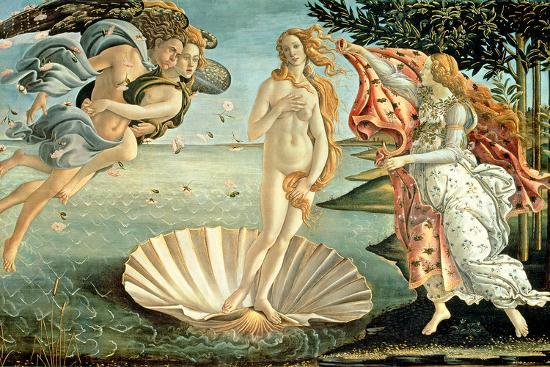The Birth of Venus
 |
| The Birth of Venus Sandro Botticelli, ca. 1485-1486 5'8" x 9'2" |
The Renaissance, it’s a new era for Europe after the historical plague spreading across Europe and resulting in losing many lives and stopping the progress of Art and architecture, themselves. Soon, it results in the rise of renovated art and architecture, making new work from inspirations in the past, and what inspired them. Well-known works from famous artists, artworks, and architecture stood in the test of time, bringing on a new generation to wonder and astound by the works from the Renaissance. It’s been mentioned in Culture and Values: A Survey of the Humanities’ Chapter 12, “By the stroke of good fortunes, Florence and its immediate surroundings produced, in the fifteenth century, a group of artists who revolutionized western art to such extent that later historians refer to the period as a renaissance (‘rebirth’) in the arts.” (Cummingham 268). Being said, Florence being one of the major cities to bring on the Renaissance era because of artists who’d worked in the western works to their own interpretation of the past as a new wave for the art world. From the research been done in Chapter 12, it’s difficult to choose which of the major paintings during this period and how it’s analyzed in closer terms of composition, gradation color, and the use of perspective the art itself. With that, the renaissance was the new era at the time, but it brought on the old techniques to a new generation of artists.
One of the major artworks to focus on the matter is The Birth of Venus made by Sandro Botticelli in c. 1482. Botticelli created another work, La Primavera (Springtime), which was created in c. 1478 and was being compared to this artwork which focused on the female figure, specifically a goddess named Venus, in the middle of the painting. With the natural, fantasy look of the artwork itself with a couple of people being next to the lady in the middle. In the text mentioned, “the Venus of this painting reflects a complex synthesis of Platonic idealism, Christian mysticism relating to the Virgin, and the Classical ideal of the female figure of Venus.” (Cummingham 283). The composition being Venus, rising with the sea with the angel caring a woman in his arm and an attendant swooping in with a red cape to drape her in after the emerge near the ocean side. The colors used in the artwork would get the sense of fantasy and natural beauty when looking at it for a couple of minutes to hours, with the hint of details along the lines of the trees, the ocean and the background itself, the fabric used and how the action of the wind flows through them, and overall, how the human bodies worked as it lines up along the painting. The perspective itself making it look how would focus on Venus first when seeing the painting and soon we would look at the other human beings and the clothing worn as she stood completely need and on top of a seashell, and later the background and the details as being mentioned previously before.
Overall, The Birth of Venus stood out among the other paintings based on how Botticelli uses inspiration from his previous works and the use of colors, the nature of beauty itself, and the example of the composition of how the work is being interpreted alongside.
Something interesting about the work itself is that Botticelli wanted to incorporate the beauty of just an average body type and how Venus was inspired by the Venus pudica, or the “Modest” Venus. Since it comes from the idea of Platonism. Mentioning how, “Botticelli is trying to depict not a particular woman but the essential idea of female beauty...reflects a complex synthesis of Platonic idealism, Christian mysticism relating to the Virgin, and the classical idea of the female figure of Venus.” (Cummingham 283). Meaning that Botticelli’s challenge to make a non-particular look to the female figure and how he would incorporate it into his works. The idea that comes to mind when researching this work is how it’s being mentioned and recognized during the Renaissance era, and how it brings on a new generation of people in the 20th century. For that, the Renaissance is an era for new artists working on new ideas for the generation to get a hold of and how the artists during that time would make well-known works that have been shown and referenced all over the world in both media and the arts.
I attached a video that discusses the work in further detail and a link to an article that also talked about the work itself coming from Tuscany.
Work Cited:
“Chapter 12: The Early Renaissance .” Culture and Values: A Survey of the Humanities, by Lawrence Cunningham et al., Cengage Learning, 2017, pp. 265–293.

Comments
Post a Comment